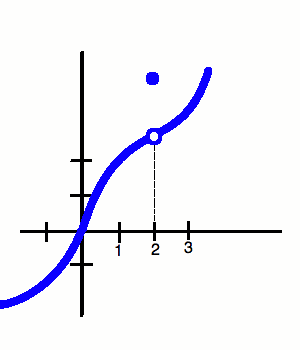Discontinuity is when the limit of a graph does not exist. A limit does not exist if there are any of these three parts which include jump discontinuity, oscillating discontinuity, and infinite discontinuity.
The picture on the right shows an example of a jump discontinuity. A jump discontinuity is basically as its name says. The graph will suddenly "jump" from one part of the graph to a higher or lower part of the previous graph.
The graph right above shows an example of an oscillating discontinuity. An oscillating discontinuity is basically a graph that looks wiggly. For example, on the graph , we can oscillating behavior where the x-axis is 0.
 The graph on the right shows an example of an infinite discontinuity. An infinite discontinuity is when a graph never reaches an exact endpoint. This can only occur when we see a vertical asymptote. For example, at 3 on the x-axis, we can see a vertical asymptote because the graph do not reach a certain point.
The graph on the right shows an example of an infinite discontinuity. An infinite discontinuity is when a graph never reaches an exact endpoint. This can only occur when we see a vertical asymptote. For example, at 3 on the x-axis, we can see a vertical asymptote because the graph do not reach a certain point.
2. A limit is the INTENDED heigh of a function. A limit is completely different form a value because a value is an exact height while a limit can be given a value although there is a hole in the graph which gives it no value. For example, on the graph below, there is a limit at (2,3) although there is a value at (2,4). Therefor the value of f(2) is equal to 3 although there is a hole in the graph. A limit can exist anywhere as long as you specify what location you are trying to find your limit at. A limit does not exist if the graph is not continuous. There cannot be a limit if there is either a jump, oscillating, or infinite discontinuity.
3. We can evaluate limits numerically, graphically, or algebraically.
-Numerically is when we use a table to find a limit based upon how close a function approaches the intended value. On the table, the intended value that the function is approaching will be in the middle. Then there will be three other spaces on the left and right of it. These three values will be the closest to the intended value. For example if the intended value is 3, the values on the left will 2.9 all the way on the left, next with 2.99, hen 2.999. Then, right next to 3 will be 3.001, then 3.01, and finally 3.001.
-Graphically is basically where you make a graph of the function so you can visually see the intended height of the function.
-Algebraically is when we use actual numbers to solve the function. The first step one should take is use direct substitution. This is when you plug in the value as x approaches a number to the variable x in the function and see if it gives you an exact value, 0, or undefined. If you get 0/0 you will have to use a different method because it is indeterminate form. You can either use the factoring method which involves you to factor out both the numerator and denominator to see if anything cancels out so that you can from then on use direct substitution again to give you an answer. The other method you can use is the rationalizing/ conjugate method which is when you multiply by the conjugate of a radical so that you can look for something to cancel. From there on, you again use direct substitution to get an answer.
References:
http://808trig.wikispaces.com/file/view/continuous_1.gif/230815466/304x236/continuous_1.gif
http://image.tutorvista.com/content/feed/u364/discontin.GIF
http://webpages.charter.net/mwhitneyshhs/calculus/limits/limit-graph7.jpg
http://www.freemathhelp.com/images/lessons/graph4.gif
http://dj1hlxw0wr920.cloudfront.net/userfiles/wyzfiles/12cf828c-12be-4ace-a420-21bd21aeb8c8.gif




No comments:
Post a Comment